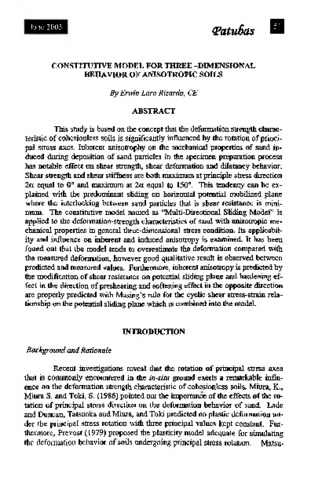Constitutive model for three-dimensional behavior of anisotropic soils
| dc.contributor.author | Rizardo, Erwin L. | |
| dc.date.accessioned | 2021-04-05T02:33:00Z | |
| dc.date.available | 2021-04-05T02:33:00Z | |
| dc.date.issued | 2005-06 | |
| dc.identifier.citation | Rizardo, E. L. (2005). Constitutive model for three-dimensional behavior of anisotropic soils. Patubas, 2(1), 51-57. | en_US |
| dc.identifier.issn | 1908-515X | |
| dc.identifier.uri | https://hdl.handle.net/20.500.12852/708 | |
| dc.description | Abstract only | en_US |
| dc.description.abstract | This study is based on the concept that the deformation strength characteristic of cohesionless soils is significantly influenced by the rotation of principal stress axes. Inherent anisotropy on the mechanical properties of sand in¬duced during deposition of sand particles in the specimen preparation process has a notable effect on shear strength, shear deformation, and dilatancy behavior. Shear strength and shear stiffness are both maximum at principle stress direction 2 an equal to 0° and maximum at 2 an equal to 150°. This tendency can be explained with the predominant sliding on horizontal potential mobilized plane where the interlocking between sand particles that is shear resistance is minimum. The constitutive model named as “Multi-Directional Sliding Model” is applied to the deformation-strength characteristics of sand with anisotropic mechanical properties in general three-dimensional stress conditions. Its applicability and influence on inherent and induced anisotropy are examined. It has been found out that the model tends to overestimate the deformation compared with the measured deformation, however, good qualitative result is observed between predicted and measured values. Furthermore, inherent anisotropy is predicted by the modification of shear resistance on potential sliding plane and hardening ef¬fect in the direction of pre shearing and softening effect in the opposite direction are properly predicted with Masing’s rule for the cyclic shear stress-strain rela¬tionship on the potential sliding plane which is combined into the model. | en_US |
| dc.language.iso | en | en_US |
| dc.publisher | Central Philippine University | en_US |
| dc.subject.lcsh | Soils | en_US |
| dc.subject.lcsh | Sand | en_US |
| dc.subject.lcsh | Soil mechanics | en_US |
| dc.subject.lcsh | Soils--Analysis | en_US |
| dc.title | Constitutive model for three-dimensional behavior of anisotropic soils | en_US |
| dc.type | Article | en_US |
| dc.citation.firstpage | 51 | en_US |
| dc.citation.lastpage | 57 | en_US |
| dc.citation.journaltitle | Patubas | en_US |
| dc.citation.volume | 2 | en_US |
| dc.citation.issue | 1 | en_US |
| local.subject | Anisotrophy | en_US |
| local.relation.associatedcontent | https://repository.cpu.edu.ph/handle/20.500.12852/909 Research report | en |
Fichier(s) constituant ce document
Ce document figure dans la(les) collection(s) suivante(s)
-
Journal articles [17]
-
Patubas [110]
Patubas is a refereed research journal of Central Philippine University.


